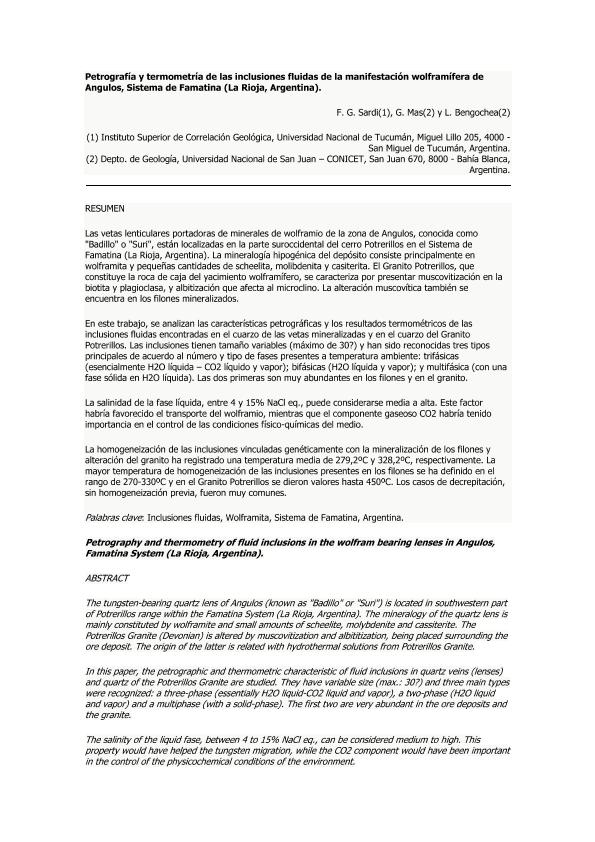Artículo
Las vetas lenticulares portadoras de minerales de wolframio de la zona de Angulos, conocida como "Badillo" o "Suri", están localizadas en la parte suroccidental del cerro Potrerillos en el Sistema de Famatina (La Rioja, Argentina). La mineralogía hipogénica del depósito consiste principalmente en wolframita y pequeñas cantidades de scheelita, molibdenita y casiterita. El Granito Potrerillos, que constituye la roca de caja del yacimiento wolframífero, se caracteriza por presentar muscovitización en la biotita y plagioclasa, y albitización que afecta al microclino. La alteración muscovítica también se encuentra en los filones mineralizados. En este trabajo, se analizan las características petrográficas y los resultados termométricos de las inclusiones fluidas encontradas en el cuarzo de las vetas mineralizadas y en el cuarzo del Granito Potrerillos. Las inclusiones tienen tamaño variables (máximo de 30?) y han sido reconocidas tres tipos principales de acuerdo al número y tipo de fases presentes a temperatura ambiente: trifásicas (esencialmente H2O líquida – CO2 líquido y vapor); bifásicas (H2O líquida y vapor); y multifásica (con una fase sólida en H2O líquida). Las dos primeras son muy abundantes en los filones y en el granito. La salinidad de la fase líquida, entre 4 y 15% NaCl eq., puede considerarse media a alta. Este factor habría favorecido el transporte del wolframio, mientras que el componente gaseoso CO2 habría tenido importancia en el control de las condiciones físico-químicas del medio. La homogeneización de las inclusiones vinculadas genéticamente con la mineralización de los filones y alteración del granito ha registrado una temperatura media de 279,2ºC y 328,2ºC, respectivamente. La mayor temperatura de homogeneización de las inclusiones presentes en los filones se ha definido en el rango de 270-330ºC y en el Granito Potrerillos se dieron valores hasta 450ºC. Los casos de decrepitación, sin homogeneización previa, fueron muy comunes. The tungsten-bearing quartz lens of Angulos (known as "Badillo" or "Suri") is located in southwestern part of Potrerillos range within the Famatina System (La Rioja, Argentina). The mineralogy of the quartz lens is mainly constituted by wolframite and small amounts of scheelite, molybdenite and cassiterite. The Potrerillos Granite (Devonian) is altered by muscovitization and albititization, being placed surrounding the ore deposit. The origin of the latter is related with hydrothermal solutions from Potrerillos Granite. In this paper, the petrographic and thermometric characteristic of fluid inclusions in quartz veins (lenses) and quartz of the Potrerillos Granite are studied. They have variable size (max.: 30?) and three main types were recognized: a three-phase (essentially H2O liquid-CO2 liquid and vapor), a two-phase (H2O liquid and vapor) and a multiphase (with a solid-phase). The first two are very abundant in the ore deposits and the granite. The salinity of the liquid fase, between 4 to 15% NaCl eq., can be considered medium to high. This property would have helped the tungsten migration, while the CO2 component would have been important in the control of the physicochemical conditions of the environment. The homogenization of the fluid inclusions genetically related with the mineralization in the quartz veins and the alteration of the granite have registered an average temperature of the 279,2ºC and 328,2ºC, respectively. The higher homogenization temperature in the quartz veins was between 270º-330ºC and, in the Potrerillos Granite up to 450ºC. The cases of decrepitation, without pre-homogenization, were also very common.
Petrografía y termometría de las inclusiones fluidas de la manifestación wolframífera de Angulos, Sistema de Famatina (La Rioja, Argentina)
Título:
Petrography and thermometry of fluid inclusions in the wolfram bearing lenses in Angulos, Famatina System (La Rioja, Argentina)
Fecha de publicación:
12/2000
Editorial:
Instituto Geológico y Minero de España
Revista:
Boletín Geológico y Minero
ISSN:
0366-0176
Idioma:
Español
Tipo de recurso:
Artículo publicado
Clasificación temática:
Resumen
Palabras clave:
Inclusiones Fluidas
,
Wolframita
,
Sistema de Famatina
,
Argentina
Archivos asociados
Licencia
Identificadores
Colecciones
Articulos(CRILAR)
Articulos de CENTRO REGIONAL DE INV. CIENTIFICAS Y TRANSFERENCIA TECNOLOGICA DE ANILLACO
Articulos de CENTRO REGIONAL DE INV. CIENTIFICAS Y TRANSFERENCIA TECNOLOGICA DE ANILLACO
Citación
Sardi, Fernando Guillermo; Mas, Graciela Raquel; Bengochea, Amado Leandro; Petrografía y termometría de las inclusiones fluidas de la manifestación wolframífera de Angulos, Sistema de Famatina (La Rioja, Argentina); Instituto Geológico y Minero de España; Boletín Geológico y Minero; 111; 1; 12-2000; 53-66
Compartir




